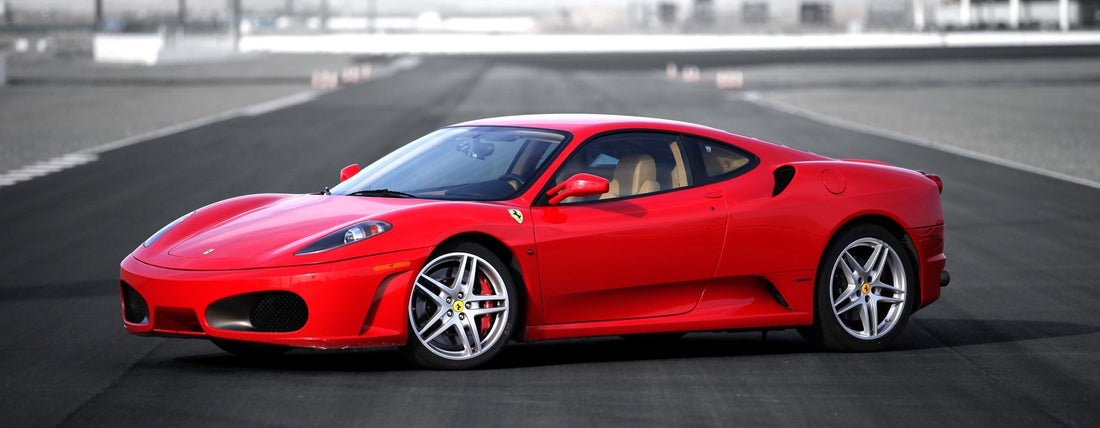I’ll never forget the first time I saw an F430 in the flesh. I was about six years old (2006) when my parents took us out to the Ferrari club’s car show that Saturday. It was heaven for a young car obsessive like me seeing dozens of supercars I would seldom see. I distinctly remember my dad lifting me up from under my armpits to see into the open engine bay of a Tour de France blue F430 coupé. I only had a few precious seconds to see the pristine red intake manifold of a spanking-new 4.3L V8, yet the memory of that engine bay and the rear of the F430 is so permanently etched into my brain.
The Ferrari F430 is arguably the most beautiful mid-engined Ferrari ever made, and they’re currently available for well under $100k. Upon first glance, the F430 seems like the final generation of the ‘old’ Ferraris and only a moderate upgrade from the currently 25% less expensive 360, but I believe the F430 is the hidden gem of the used modern Italian supercar market and the perfect balance between the ‘old Maranello’ and the new. It was also the last flagship Ferrari to be offered in a gated manual. And while this next detail may have no relevance, it was also the last flagship Ferrari to be sold during a time when Ferrari was winning Formula One championships. Finally, it was one of the poster-cars of a generation- well my generation- and especially for the nutty-into-car kids like me.

I know most people reading this will know the numbers already, but why not refresh our memories? It is a near 15 year old car after all. From an all new 4.3L V8, the standard F430 made 483hp and 343 lb/ft of torque. They aren’t immediately impressive numbers but a KG per horsepower figure of 3.14 is still relevant today and only marginally lower than the standard Murcielago’s figure of 3.22 which had a chunky V12. The F430 also featured a much more rigid chassis over the 360, improvements in safety, 50% less lift while maintaining the same coefficient of drag (with the help of a new gargantuan rear diffuser), a revolutionary active limited slip differential called the E-diff, and of course a revised but still inherently Ferrari interior among other small bits.
These stats are the bare minimum of new features worth mentioning, but they are relatively unimportant for the purpose of this article. These articles are primarily about finding cars that you can enjoy without winging everytime the odometer ticks up another mile - and while simultaneously retaining or even making a bit of money when you’re ready for the next car. Certain high spec variations (especially manuals) will inevitably appreciate in value. The combination of a naturally aspirated high-revving V8, a gated manual, and the increased reliability over any of the previous Ferraris (that shared a 30 year old powertrain design) makes the F430 an enticing and practical proposition. With the 360 being $20-40k cheaper, the market has largely diverted its attention from the F430, so that leads me to believe the time is right to pick one up.
Generationally, the F430 is very much in a small yet influential category. Thirty year old cars (late 80s Porsches, early 90s Japanese cars) are taking most of the financial attention. The people who grew up with those cars can finally afford to pay what they want for their childhood dream car. That’s not so say that thirty years is the magic number, but I believe it depends on a multitude of factors including the price bracket of the vehicle. There are some pricier 80s cars (the F40 for example) that I think have plenty of room to appreciate but that’s for another article. The point is that the F430 is a poster car of a young generation that can’t yet afford to buy their childhood dream car, and there is such a variety of new performance cars that a good portion of the ‘new money’ is preferring to buy one of them over having a small collection of ‘modern classics.’ It makes sense really given that there are fewer people who know how to work on their own cars or even how to drive a manual, so the priority for younger generations, even for supercar shopping, has been put on reliability and ease of use; however, I do believe that the number of ‘young enthusiasts’ will match the number of available modern classics. I believe the rate at which production numbers increase is proportional to the rate of increase of car enthusiasts - surely that’s the only reason why production numbers has so rapidly expanded.

Anyway, back to the F430. If you are looking to buy one, there are a few things things to look out for which also depend on your purpose for the car. If you want a real investment, you need to be looking at an ultra-low mileage high/rare spec example (probably a Scuderia or a 16M) which will already cost you at this point, so my advice is to buy a standard F430 as a driveable weekend car.
In the current market, the main factors that affect price are (in order of significance): gearbox, condition, mileage, year, color/spec. This trend is somewhat different than it would have been five years ago. It brings up two interesting points in particular. The first is mileage having low influence for pricing. It means you can get a relatively low mileage car without feeling like you need to compromise on options. The second point is the lack of priority the market has put on options. There were a heap of incredibly expensive options available when the car was new, and, believe it or not, they were even more extortionate than the options list of most modern supercars.
Back in the early to mid 2000s, you couldn’t sell a performance car without carbon fiber being an option regardless of whether or not it enhanced performance. I distinctly remember pointing instances of it out to my parents or anyone unfortunate enough to be in my vicinity when I would gawk over a supercar. Being the must-have option of the day, most of the big ticket items on the options list included carbon in some form. The most expensive of which for the F430 were the carbon-ceramic brakes ($16,800), the carbon fiber engine compartment ($10,000), and the challenge-style rear grill in carbon ($2,700). Out of 48 options on offer in 2006, only ten were under $1,000. Even basic leather and alcantara options were on offer for near $5,000.
With the already steep base price of the car for the time ($186,000 at its lowest point), many pinched their pennies when it came to options. Because of that, the range of spec on the market varies heavily, and the most expensive of the options are harder to come by than on modern supercars where everyone seems to prioritize options for resale purposes. That being said, I find it odd that spec doesn’t affect price more than it does. You can find a car that has seemingly all the expensive carbon bits, daytona seats, ceramic brakes, and the rest of the lot, but it can be the same price as a similar mileage/year/gearbox car for seemingly no reason that I can identify at least. This is a good thing for buyers though. It means, if you’re patient enough to look for it, you can buy exactly what you want without having to pay much if anything for it.
Unlike the 360, the F430 has very little price fluctuation when it comes to mileage. In fact, you can very easily find a 10,000 mile car for less than a 35,000 mile car. Normally in a situation like this where you want a driveable modern classic, I would recommend buying a medium mileage car you don’t feel needs to be babied; however, because it has very little factor, I would make sure you source a car with 7,000 - 15,000 miles. This really is the best of both worlds. On one hand, if you are absolutely in love with the car and can’t stop driving it, then don’t. The servicing costs are about $1,200 annually bar at the 15,000 mile engine service intervals. On the other hand, if the market starts rising quick enough to think about selling in the near future, you’ll still have a low-mileage car that should sell quickly when it inevitably returns to a seller’s market. This combination of factors is an incredibly rare phenomenon, especially with a generational ‘poster car.’

Like I mentioned earlier, spec isn’t a huge factor for value in the current market, so I would be patient and wait for the right spec for you. The must-have options for me are: a manual gearbox, full interior carbon, daytona seats, crema leather, rosso corsa/black/TdF blue exterior, scuderia fender shield, HIFI sound, parking sensors, and ideally carbon ceramics although they didn’t have all that much of a performance difference over steel discs back then.
With all that being said, I can say with confidence that the time to buy the F430 is now. It will only become more popular as the younger generations who grew up adoring it and the older generations who miss the ‘old Ferrari’ remember just how special the F430 was and, frankly, still is. It’s a buyer’s market right now, and if you look at the trends of previous game-changing mid-engined manual Ferrari’s, you’ll see the demand for the F430 is steadfastly approaching.

